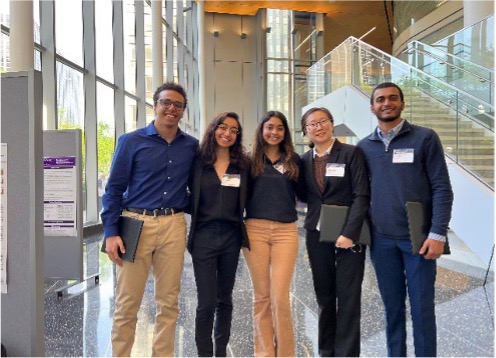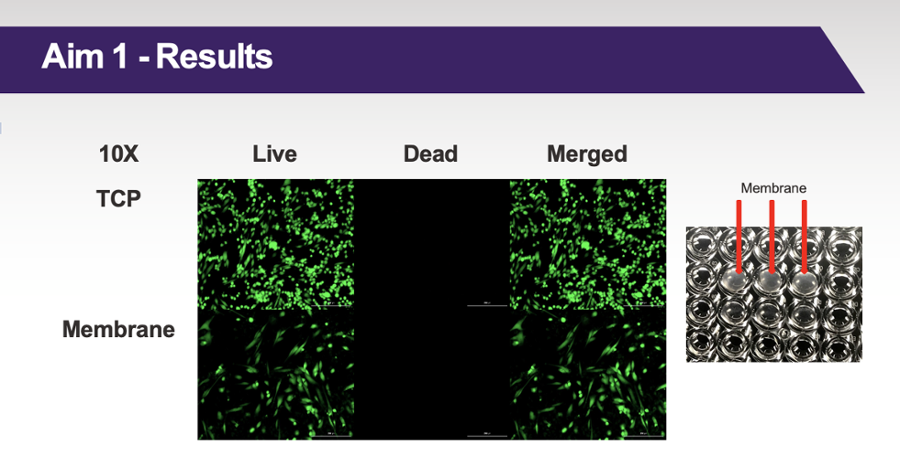Student ProjectsCompetition for Undergraduate Regenerative Engineering (CURE)
 Project Manager
Project Manager
Emma Rens, Student
Amount Requested
$9,858
Summary
Northwestern’s Competition for Undergraduate Regenerative Engineering (CURE) is a student-run organization which provides the opportunity for undergraduate students to engage in cutting-edge research in the field of regenerative biomedical engineering. The mission of the club is to enable students from diverse backgrounds to work together in development of novel therapies for global medical problems. The club is open for all to join and provides valuable hands-on lab training and research experience for new students while enabling more seasoned members to expand their skills in project management and experimental design. For the past few years, CURE has focused on treatment of cutaneous chronic diabetic wounds with the goal of enhancing wound closure rates and the quality of healed tissue. During the 2023-2024 academic year, student-led teams will continue development of three competing therapies, bio-active glass salves, copper-releasing hydrogel wound dressings, and wound-conforming polymer bandages for controlled exosome release. Through synthesis and characterization of materials, in-vitro studies of biocompatibility, and in-vivo studies of efficacy, the teams will develop bodies of evidence for presentation at the 2024 CARE Symposium on Regenerative Engineering. Each team’s presentation will be judged on the quality of their designs, lab work, and ultimate results with the winning team receiving the opportunity to continue their research and work towards publication. CURE offers a unique opportunity for undergraduates to freely devise their own strategies to tackle pressing biomedical challenges and realize these ideas in a highly collaborative environment. Under the guidance of graduate students and faculty in the Center for Advanced Regenerative Engineering (CARE), students will expand their abilities in vital laboratory techniques, foster working relationships with research mentors, and complete research projects which increase competency and equip them for future research in the field of biomedical engineering.

Planned Activities/Investments
In order to promote students from diverse backgrounds working together to explore the field of regenerative engineering, CURE works in multidisciplinary teams each using their own novel idea for a medical therapy, currently for diabetic wound healing. In order to develop their therapies, each team conducts thorough research, both bench-top fabrication and data collection in a laboratory setting as well as dry lab background research, formulation of ideas, and data analysis. Each team recruits new students each school year from different backgrounds to help with various aspects of developing the therapy. For example, biology and biomedical engineering students are often involved in brainstorming and wet lab cell culturing, materials science students often work on fabricating treatment materials like hydrogels, data science students often work on data analysis, and business students help research the available market as well as optimal FDA regulatory pathway for the therapy. Team collaboration takes place through many work sessions and meetings to keep everyone apprised of progress. There are monthly all team meetings where teams give updates and bounce ideas off each other and weekly team meetings where teams give progress updates from the week and plan next steps.The largest whole-club activity is the Biannual International CARE Symposium on Regenerative Engineering where teams spend two years working towards presenting their data. In essence, the main activity for CURE members is research. CURE provides the unique opportunity for any undergraduate to get thoroughly immersed in a research project in which they make all the decisions and run their own experiments. While graduate student advisors are available for guidance, all planning and lab work is done by undergraduates. Thus, Murphy grant funding would go towards furthering this research through things like reaction reagents and access to necessary instruments like a nanoparticle tracking analysis instrument.
Impact
The impacts of the three projects conducted within the Competition for Undergraduate Regenerative Engineering in the upcoming year are many-fold. In the broader scope, this research will add knowledge to the growing field of regenerative engineering and specifically chronic wound healing. The copper- releasing hydrogel project provides an inexpensive alternative to modern wound dressings with added anti-microbial and healing properties from copper, the exosome bandage project will expand the use of photo-controlled exosome release to topical hydrogel dressings, and the bio-active glass project will investigate the application of powdered glasses for copper delivery. The findings of these projects have the potential to inform future research in chronic wound therapies and improve outcomes for patients of chronic diabetic wounds. In addition to these academic impacts, CURE creates an inclusive community of open-minded young biomedical researchers at Northwestern. This community is vital to excite undergraduates about medical research and expand their skills in lab technique, lab safety, synthetic design, professional communication, and project management. Overall, participation in CURE better prepares its members for future research in graduate school or in industry. The club helps to build a stronger research culture among undergraduates and promotes scientific curiosity and discovery at our school.
Sustainability
CURE is a relatively new club on campus. Due to high interest among students and the valuable research skills it affords participants, it is expected to be ongoing for future years. Beyond the limits of Murphy funding, we are also pursuing other grants such as those from McCormick Student Advisory Board (MSAB), and Associated Student Government (ASG). Through our work with Professor Ameer, we also receive some support from the Center for Advanced Regenerative Engineering (CARE).
Deliverables
The first major deliverable is presenting at the Biannual Symposium on Regenerative Engineering. This is where the ‘competition’ in Competition for Undergraduate Regenerative Engineering comes into play as each team is given 7 minutes to present their research proposal and data. The team with the most promising diabetic wound treatment will be eligible for publication in the Journal of Regenerative Engineering and Translational Medicine. Another major deliverable are poster presentations at the annual BMES and Chicago Undergraduate Research conference. This is again an opportunity for teams to present their research as well as networking with others in similar fields.
Budget Overview
- $6,858.18 Mice for Animal Studies: diabetic and 18 non-diabetic mice will be needed for each team’s in-vivo study to evaluate their developed therapies for diabetic wound healing. Diabetic mice cost $103 per animal and non-diabetic mice cost $24 per animal.
- $2,000 Reagents and Test Kits: Each team will need additional reagents for further synthesis of their materials and in-vitro characterization. Further synthesis of materials will require purchase of additional glass powder, polydopamine, and photolabile esters for the teams. Additionally, various antibodies, staining kits, and medium must be purchased for characterization of cell response.
- $1,000: Northwestern Facilities: Additional funds are requested for use in Northwestern facilities including NUANCE and ANTEC. Team will utilize facilities for spectroscopy, microscopy, rheology, and nano-tracking analysis among other techniques.
Total: $9,858
Advisor
CURE - Guillermo Ameer, Biomedical Engineering
